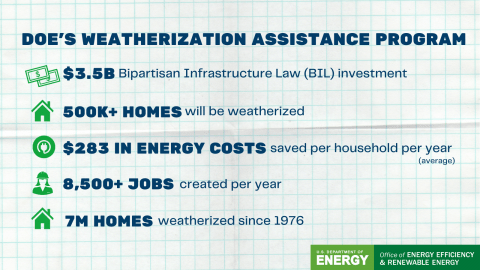With an unprecedented $3.5 billion to invest in increasing energy efficiency and safety in more than half a million low-income households across the nation, the U.S. Department of Energy’s Weatherization Assistance Program (WAP) is poised to help many Americans save money on their energy bills. The Biden-Harris Administration’s Bipartisan Infrastructure Law (BIL) will improve insulation and air sealing, heating, ventilation, air conditioning systems, lighting, and appliances in American homes while lowering energy costs for American families.
The Jones family of Waynesboro, Georgia, can speak to the tangible—and potentially life-saving—benefits of home weatherization. When the Joneses were struggling to pay their heating and cooling bills, Georgia’s weatherization program funded and arranged a home energy audit to help reduce their energy use. The auditor found a gas leak and an exposed wire in the family’s attic that was burning insulation and creating smoke. The family evacuated just before a fire broke out. After repairs, WAP completed its weatherization, and the Jones family’s energy bills decreased by an average of $120 a month. You can watch the Joneses tell their story here.
Before BIL, WAP provided weatherization services to about 35,000 low-income households each year with its annual budget of over $300 million. Thirty-nine million low-income households are eligible to receive weatherization services, but with that budget, the program reached only about 2% of eligible households. That percentage will significantly increase with the BIL investment, improving the health, safety, and comfort of people in communities that have historically suffered energy injustices.
This investment is key to lowering the energy burden among low-income households, which spend an average of nearly 14% of their annual income on energy costs, compared to 3% for higher income households. This burden often compels families to cut back on health care, groceries, child care, and other essentials to pay their energy bills. Today, WAP services help low-income families save an average of $283 on energy costs every year.
But the benefits of weatherization extend beyond energy savings. Weatherization turns homes into healthier environments, resulting in fewer missed days of school and work and lower out-of-pocket medical expenses at an average of about $514 per year. Each home that receives WAP services gain an average of $14,148 in total health- and household-related benefits.
WAP also supports roughly 8,500 good-paying jobs each year, strengthening the local economy and empowering the people in the communities it serves.
And it is cost-effective. For every dollar of federal investment, the program generates $1.72 in energy-related benefits and $2.78 in other benefits. The returns on these investments can transform communities. They also align with several DOE priorities: achieving a net-zero carbon emissions economy-wide by 2050, addressing historical energy and environmental injustices, and expanding the clean energy workforce.
Since Congress established WAP in 1976, the program has served more than 7 million households in every county and state, the District of Columbia, and the five U.S. territories. Thanks to BIL, many more Americans will get the weatherization assistance they need.

